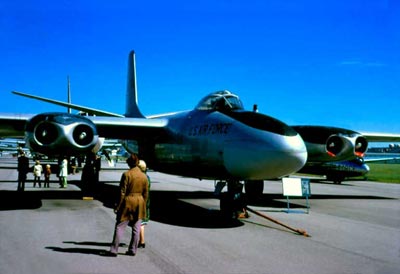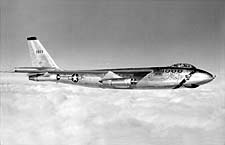|
THE WAR CONTINUES |
||||||||||||||||||||||||||||||||||||||||||||||||||||||||||||||||||||||
| The bombing by the B-29s and the surveillance by the 91st SRS had been successful due to one fact. There was a real lack of enemy opposition. This situation was about to change dramatically. After the Migs made their appearance, North Korea suddenly became a dangerous place. Migs were now swarming across the border in groups of 100 or more. Our B-29 losses were mounting, and the 91stSRS was being ripped apart at will. Also being used were Radar controlled anti-aircraft guns. On Oct. 1st the 91st was ordered to suspend operations near “Mig Alley”, and the Sinuiju, Sinanju area. Photo recon missions from then on would be carried out by RF-80s. | ||||||||||||||||||||||||||||||||||||||||||||||||||||||||||||||||||||||
|
|
||||||||||||||||||||||||||||||||||||||||||||||||||||||||||||||||||||||
|
AIRCRAFT LOSSES |
||||||||||||||||||||||||||||||||||||||||||||||||||||||||||||||||||||||
|
The Soviets claimed a total of 1300 UN aircraft destroyed during the war. They claim 345 Migs lost in combat and accidents. FEAF claims 792 Migs destroyed and 58 Sabres lost. After the war the USAF admitted to 103 Sabres lost, and the Mig kills at 379. |
||||||||||||||||||||||||||||||||||||||||||||||||||||||||||||||||||||||
| COMMENTS: | ||||||||||||||||||||||||||||||||||||||||||||||||||||||||||||||||||||||
| I spent hours
researching books, government records, Internet web sites, and Russian
reports` trying to finalize the losses. The discrepancies are sizeable.
The very best I can come up with is the following: During the Korean War, June 25, 1950, to July27, 1953, the U.S. suffered 142,091 casualties including 33,665 deaths, 3,275 killed in accidents for a total of 36,940. 92,134 were wounded, 8,176 STILL MISSING IN ACTION. 1,789,000 served during the war. South Korea reports 1,312.836 military casualties with 415,000 dead. Our U.N. Allies report 16,532 casualties and 3,094 dead. Communist losses are reported as an unconfirmed two million. The U.S. at first claimed 792 Migs destroyed, however documented postwar research indicates not 792 but 379. The U.S. reports 34 B-29s destroyed. USAF losses were comparatively light, with 1,841 casualties including 379 killed in action and 821 MISSING IN ACTION and presumed dead. 224 airmen were captured with only four deaths reported, compared with U.S. troop statistics of 2,701 men who died out of 7,140 captured. |
||||||||||||||||||||||||||||||||||||||||||||||||||||||||||||||||||||||
|
|
||||||||||||||||||||||||||||||||||||||||||||||||||||||||||||||||||||||
| AN ENDING TO A FORGOTTEN WAR | ||||||||||||||||||||||||||||||||||||||||||||||||||||||||||||||||||||||
|
On July 27, 1953, both sides were ready to sign an armistice. The last plane to fly over was an RB-29 from the 91st SRS which dropped leaflets. The ground war had ceased, all was quiet, the conflict was over. The Korean war had proved absolutely nothing, we were back at the 38th Parallel. To most of the Korea veterans the war is only a fading memory, soon to be completely forgotten. Most never voiced their opinion, never complained, never demonstrated. Most never were asked to tell their stories, and now, their memories are fading as quickly as their photographs. There are very few books about the air war, practically no movies. The Korea Veteran is destined to leave this earth without ever understanding the apathetic attitude shown them by the American People. |
||||||||||||||||||||||||||||||||||||||||||||||||||||||||||||||||||||||
|
COMMENT: All statements are the opinion of Wayland Mayo, web site historian. All photos by Mayo except where noted otherwise. |
||||||||||||||||||||||||||||||||||||||||||||||||||||||||||||||||||||||

